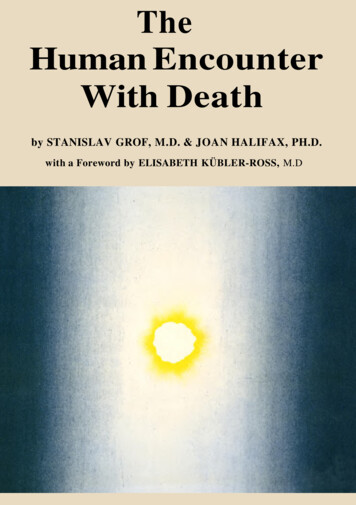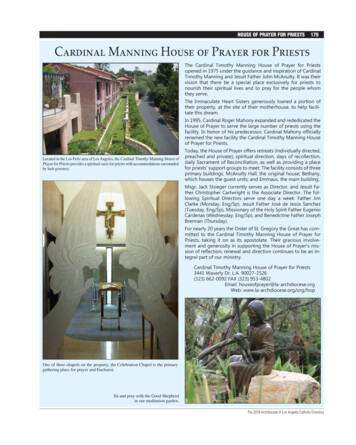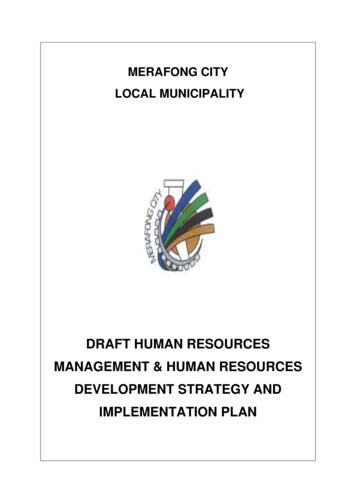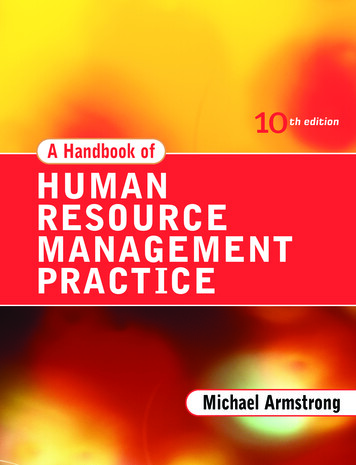
Transcription
TheHuman EncounterWith Deathby STANISLAV GROF, M.D. & JOAN HALIFAX, PH.D.with a Foreword by ELISABETH KÜBLER-ROSS, M.D
D 492/A Dutton Paperback/ 3.95/In Canada 4.75S t a n i s l a v Grof, M.D., a n d J o a n H a l i f a x , Ph.D., have aunique authority and competence in the interpretation ofthe h u m a n encounter with death. Theirs is an extraordinary range of experience, in clinical research with psychedelic s u b s t a n c e s , in cross-cultural and medicalanthropology, and in the analysis of Oriental and archaicliteratures. Their pioneering work with psychedelics administered to individuals dying of cancer opened domainsof experience that proved to be nearly identical to those already mapped in the "Books of the Dead," those mysticalvisionary accounts of the posthumous journeys of the soul.The Grof/Halifax book and these ancient resources bothshow the imminent experience of death as a continuation ofwhat had been the hidden aspect of the experience of life.—Joseph CampbellThe authors have assisted persons dying of cancer in transcending the anxiety and anger around their personal fate.Using psychedelics, they have guided the patients to deathrebirth experiences that resemble transformation ritespracticed in a variety of cultures. Physician and medicalanthropologist join here in recreating an old art—the art ofdying.—June SingerThe Human Encounter With Death is the latest of many recent publications in the newly evolving field of thanatology.It is, however, a quite different kind of book—one that belongs in every library of anyone who seriously tries to understand the phenomenon we call death.—from the Foreword byElisabeth Kübler-RossCover design by Leo MansoISBN: 0-525-47492-70378
THE HUMAN ENCOUNTERWITH DEATH
S TANISLAV G ROF , M.D., worked with psychedelic drugs at thePsychiatric Institute in Prague before joining the MarylandPsychiatric Research Center in 1967. Author of over sixtyarticles in this field and the book Realms of the Human Unconscious: Observations from LSD Research, he is nowscholar-in-residence at the Esalen Institute in Big Sur, California.J OAN H ALIFAX , Ph.D., is a medical anthropologist, specializingin psychiatry and religion. She is presently working with themythologist Joseph Campbell. She has done research at Columbia University, the Musee de l'Homme in Paris, the University of Miami School of Medicine, and the Maryland Psychiatric Research Center.
TheHumanEncounterWith DeathSTANISLAV GROF, M.D.,JOAN HALIFAX, Ph.D.WITH A F OREWORD BYE LISABET H K Ü BLER -R OSSADuttonPaperbackE.P. DUTTONNEW YORK
Grateful acknowledgment is made to the following:For permission to use copyrighted material from Memories, Dreams, Reflections by C. J.Jung, edited and recorded by Aniela Jaffe, translated by Richard and Clara Winston.Copyright 1963 by Random House, Inc. Reprinted by permission of Pantheon Books, aDivision of Random House, Inc.For permission to use copyrighted material, an excerpt from "I Died at 10:52A . M .,"byVictor D. Solow, The Reader's Digest, October 1974. Copyright 1974 by the Reader'sDigest Association, Inc. Used with permission.For permission to use copyrighted material from the American Journal of Psychiatry,Vol. 124, pp. 84-88, 1967. Copyright 1967, the American Psychiatric Association.Reprinted by permission.For passages from Glimpses of the Beyond by J. B. Delacour, Delacorte Press, 1974.This paperback edition ofThe Human Encounter With Deathfirst published 1978 by E. P. Dutton, a Division ofSequoia-Elsevier Publishing Co., Inc., New York.Copyright 1977 by Stanislav Grof, M.D. and Joan Halifax, Ph.D.Foreword copyright 1977 by Elisabeth Kübler-Ross, M.D.All rights reserved. Printed in the U.S.A.No part of this publication may be reproduced ortransmitted in any form or by any means, electronic ormechanical, including photocopy, recording or any informationstorage and retrieval system now known or to be invented, withoutpermission in writing from the publisher, except by a reviewerwho wishes to quote brief passages in connection witha review written for inclusion in a magazine,newspaper or broadcast.Library of Congress Cataloging in Publication DataGrof, Stanislav, 1931The human encounter with death.Bibliography: p.Includes d diethylamide. I. Halifax, Joan, joint author.II. Title.BF789.D4G76 1977155.9 3776-55419ISBN: 0-525-47492-7Published simultaneously in Canadaby Clarke, Irwin & Company Limited,Toronto and Vancouver10987654321
CONTENTSText added by the OCR:r:The page numbers in the documentmay not be correct, therefore the pagereferences in contents and index mayalso be incorrect.But the links in contents andbookmarks works fine.Foreword by Elisabeth Kübler-Ross, M.D.viAcknowledgmentsix1.The Changing Face of Death2.The History of Psychedelic Therapy with the Dying133.The Spring Grove Program264.Dimensions of Consciousness: A Cartography of theHuman Mind40The Human Encounter with Death: PsychedelicBiographies635.16.Psychedelic Metamorphosis of Dying1087.Consciousness and the Threshold of Death1318.The Posthumous Journey of the Soul: Myth and Science1589.Death and Rebirth in Ritual Transformation19010.Dialectics of Life and Death204Bibliography222Index229
FOREWORD BYELISABETH KÜBLER-ROSSThe Human Encounter With Death is the latest of many recentpublications in the newly evolving field of thanatology. It is, however, aquite different kind of book—one that belongs in every library of anyonewho seriously tries to understand the phenomenon we call death.Anyone interested in psychosomatic medicine and its correlations, aswell as those involved in the clinical use of the psychedelic experience,should read this book. It is a Pandora's box of information as well as agood historical review. The author, who is an already well-known andtalented writer and an extremely bright and well-read researcher, actuallytakes you on a fascinating journey through The Egyptian Book of theDead, through LSD experiences and its possible application, throughnear-death experiences associated with drownings and accidents, to themany different points of views and theoretical interpretations of thesubjective experiences of the dying. This book is long overdue in ourdrug-oriented society.As Grof, himself, states, the experiences of dying individuals cover awide range, from the abstract to aesthetic sequences—from relivingtraumatic and positive childhood memories and episodes of death andvi
Foreword viirebirth to profound archetypal and transcendental forms of consciousness.This work is not really a summary of human encounters with death; infact it deals very little with the natural experiences of dying patients. It iswritten almost exclusively by a man whose real contribution is the betterunderstanding of the use, application, and understanding of psychedelicdrugs, altered states of consciousness, and special reference to the time oftransition we call death. He deals with the phenomenon of pain and itsalteration with LSD; the transformation of unsuccessful suicide patientsafter jumping from the Golden Gate Bridge; the changing values ofindividuals who have "been on the other side"—whether through the useof drugs, spontaneous cosmic experience or a close death encounter.It is interesting to note that of Karlis Osis' 35,540 reported cases of"death observations," only 10 percent of dying patients seem to havebeen conscious in the hour preceding death. It is my personal opinion thatour heavy emphasis on "drugging'' patients prior to their deaths is a greatdisservice to them and to their families. Patients who were not heavilymedicated in their final hours were able to experience these blissful statesprior to their transition, resulting in a knowledge (rather than a belief) of awaiting, loving presence of another being, of an existence (rather than aplace) of peace and equanimity, of a state of well-being and wholeness—transcending all fear of death.The vision with a predominantly non-human content is also typical, as itrepresents the in-between phase of the patient's weaning off earthlyinterpersonal relationships, prior to the contact with the "guiding hands''that will help all of us in the transition from this plane to the next one.It may be reassuring for those who lost a loved one through suicide thatthe survivors of these near-death experiences were not riddled with guiltand shame—which we tend to impose on them—but rather with a senseof new hope and purpose in being alive.Grof's and Halifax's Human Encounter With Death, together withOsis' pioneering work and Raymond A. Moody's published and soon-tobe published material, will help the many sceptics to reevaluate theirposition, to raise questions rather than to reject the new area of research inexistence after physical death. They should ask themselves why there are
viii Forewordso few differences in the stories of these people, and why there is thisrecurrence of certain motifs and themes in remote countries, and differenttime periods, and cultures, and religions.
ACKNOWLEDGMENTSThe authors would like to express their gratitude and appreciation toall those colleagues and friends at the Maryland Psychiatric ResearchCenter in Catonsville, Maryland, who contributed to the Spring Grovestudies of psychedelic therapy with individuals dying of cancer. Theresults of this research endeavor represented the most powerful stimulus for the inception of the interdisciplinary analysis of the death experience which constitutes this book.The person whose enthusiasm, energy, and dedication were essential for the launching of the programs of LSD and DPT psychotherapywith cancer patients was Walter Pahnke, M.D., Ph.D.; his backgroundin medicine, psychology, and religion, combined with his unique personality, made him the ideal person to head the research of psychedelic therapy with the dying. Walter himself died a tragic death inJuly 1971, before he could see the completion of his projects.We would like to give special notice to William Richards, Ph.D.,who contributed to both the LSD and DPT studies in the role of therapist as well as conceptual thinker. In various stages of research otherix
x Acknowledgmentsstaff members of the Maryland Psychiatric Research Center participated in the cancer project as psychedelic therapists. Grateful acknowledgment is made to Sanford Unger, Ph.D., Sidney Wolf, Ph.D.,Thomas Cimonetti, M.D., Franco DiLeo, M.D., John Rhead, Ph.D.,John Lobell, and Lockwood Rush, Ph.D. The latter, together withRichard Yensen, Ph.D., and Mark Schiffman, operated the mediadepartment at the center. As a result of their commitment and enthusiasm, much of the case material described in this book has been preserved in the form of videotape records. Another member of the research team at the Maryland Psychiatric Research Center, HelenBonny, contributed to the studies in a unique combination of roles asmusical advisor, co-therapist, and research assistant. In addition, wewould like to extend our gratitude to Nancy Jewell, Use Richards, andKaren Leihy for their sensitive and dedicated participation in the project as nurses and co-therapists; all three showed extraordinary interest,enthusiasm, and initiative in their work and accepted with great understanding all the extra duties imposed on them by the unusual nature ofpsychedelic therapy with cancer patients.Special appreciation is due Albert A. Kurland, M.D., director of theMaryland Psychiatric Research Center and assistant commissioner forresearch of the Maryland State Department of Mental Hygiene. Although his responsible position and complex administrative dutiesmade it impossible for him to participate in actual clinical work on theproject, his role as coordinator, facilitator, and advisor was crucial.Charles Savage, M.D., associate director of the Maryland PsychiatricResearch Center, deserves respectful acknowledgment for the invaluable support and encouragement he granted to the projects over theyears.The experimental programs of psychedelic therapy could not havebeen carried out without the unique understanding and cooperation ofLouis E. Goodman, M.D., attending surgeon and head of the Oncology Clinic at Sinai Hospital. Also, several other members of the medical staff of this hospital deserve appreciation for their interest, help,and willingness to provide their resources for this unexplored and
Acknowledgments xihighly sensitive area. Among these we gratefully acknowledge AdolphUlfohn, M.D., and Daniel Bakal, M.D.*Special acknowledgment should be granted to the agencies thatprovided the necessary funding for the Spring Grove research endeavors, namely the Department of Mental Hygiene of the State ofMaryland and the National Institutes of Health. Especially significantwas the help of the Mary Reynolds Babcock Foundation, whose financial support at a most critical time allowed these activities to be expanded in depth. We also remember with gratitude the administrativeand financial help of the Friends of Psychiatric Research, Inc.We are indebted to our many friends and colleagues who havehelped us put the clinical data and observations into a broader interdisciplinary perspective. Among these we particularly appreciate the contribution and catalyzing influence of Margaret Mead, Ph.D., and MaryCatherine Bateson, Ph.D. In July 1973, they invited us to a symposium entitled "Ritual: Reconciliation in Change" that they had conceived and coordinated. During long and stimulating discussions withthirteen other participants that took place for nine days at Burg Wartenstein in Austria, some of the ideas expressed in this book originatedwhile others crystallized and took a more concrete form. We also extend our sincerest thanks to Lita Osmondsen, president of the WennerGren Foundation, which sponsored the Austrian symposium, for making this unique interdisciplinary exchange possible, as well as for herextraordinary hospitality.Our theoretical thinking in the area of death and dying has beendeeply influenced by the work of Russell Noyes, M.D., professor ofpsychiatry at the University of Iowa, who drew our attention to the* It seems appropriate in this context to clarify a point of basic importance: Theresults of the Spring Grove studies have been described in a number of papers read atprofessional meetings and published in scientific journals; these articles are included inthe bibliography of this book. Those of the above researchers who co-authored thesepapers are responsible only for the information and conclusions that were expressed in thatform. The interdisciplinary excursions in this book extend far beyond the framework ofthe original clinical papers. The speculations and opinions expressed in this volume areentirely our responsibility (S. G. and J. H.).
xii Acknowledgmentsphenomenology of near-death experiences and the subjective concomitants of clinical death. The invaluable data provided by Noyes made itpossible for us to recognize that the inner cartography developed inLSD research is applicable to this area. This was an important step indeveloping a deeper understanding of the universal and central significance of the death experience. David Rosen, M.D., of the LangleyPorter Neuropsychiatric Institute in San Francisco, made it possible forus to study the data from his research of survivors of suicidal jumpsfrom the Golden Gate Bridge long before this material was published.We hereby acknowledge our gratitude to both of these researchers.One person has to be mentioned in a special category. Since ourfirst encounter several years ago, our meetings with Joseph Campbellhave been a rare combination of intellectual feast, apotheosis of art,spiritual event, and joyous reunion. His influence on our lives as ateacher and dear friend has been paramount. By sharing with us in hisspecial way his encyclopedic knowledge and deep life-wisdom, he hasopened our eyes to the relevance of mythology for a deeper understanding of human life and death.We are both grateful to Esalen Institute at Big Sur Hot Springs,California, for giving us ideal conditions in which to develop our concepts and work on a series of books. Within the framework of Esalenwe have been able to create an ongoing experimental educational program for professionals; the intense interactions with our guest facultyand participants in these unusual events have been a rich source ofideas and professional inspiration. Our sincerest thanks are extended toMichael Murphy, Richard Price, Janet Lederman, Andrew Gagarin,Julian Silverman, and all our other friends at Esalen. Of these, RickTarnas gave us invaluable help in various stages of the writing andediting of the manuscript.Those whose contribution to this volume was absolutely essentialcannot be mentioned by name; we are deeply indebted to them andremember them with utmost gratitude. Many hundreds of psychiatricpatients and LSD subjects who during their psychedelic sessions explored the realms of death in this modern version of a rite of passagevolunteered their experiences and the knowledge that they acquired
Acknowledgments xiiiduring their inner journeys. Our most valuable teachers were personssuffering from cancer and facing the imminence of biological death,for whom symbolic encounters with death in their psychedelic sessionswere an immediate preparation for their last journeys. Their contributions to this volume are inestimable; without the gracious sharing onthe part of these courageous individuals and their families, this volumecould not have been written.Esalen InstituteBig Sur, CaliforniaOctober 1976
THE HUMAN ENCOUNTERWITH DEATH
1.THE CHANGING FACEOF DEATHDeath is one of the few universal experiences of human existence. It isthe most predictable event in our lives, one that is to be expected withabsolute certainty. Yet the nature of death is immersed in deep mystery. Since time immemorial the fact of our mortality has stimulatedhuman fantasy and found incredibly varied expression in the realms ofreligion, art, mythology, philosophy, and folklore. Many extraordinary works of architecture throughout the world have been inspired bythe mystery of death: the monumental pyramids and sphinxes of Egyptand its magnificent tombs and necropolises; the mausoleum in Halicarnassus; * the pre-Columbian pyramids and temples of the Aztecs, Olmecs, and Mayans; and the famous tombs of the great Moghuls, suchas the Taj Mahal and the Monument of Akbar the Great. According to* The mausoleum of Halicarnassus was the tomb of Mausolus of Caria, a provincialgovernor of the Persian Empire who died in the year 353 B.C. It was built by a group ofsculptors at the request of his devoted sister and widow, Artemisia, and became one ofthe seven wonders of the ancient world because of its unusual form, rich decoration, andexquisite finish. The mausoleum consisted of thirty-six columns resting on a high baseand supporting a marble pyramid capped by a four-horse chariot.1
2 The Human Encounter With Deathrecent research, even the legendary Minoan palace in Crete was not aroyal residence but, rather, a gigantic necropolis.*The enigmatic nature of death opens a wide range of possibilities forindividual and collective imagination. To take only a few examplesfrom Western culture, people have seen death as the Grim Reaper,Terrible Devourer, Abominable Horseman, Senseless Automaton, Implacable Punisher, Gay Deceiver, Passionate Lover, Sweet Pacifier,and Great Unifier. The emotions associated with these images cover abroad spectrum, from a profound sense of horror to feelings of ecstaticrapture.Different concepts of death and associated beliefs have a deep influence not only on the psychological state of dying people but also onthe specific circumstances under which they leave this world and onthe attitudes of their survivors. As a result of this, dying and death canbe understood and experienced in many different ways. From thispoint of view it is interesting to compare the situation of a person facing death in contemporary Western civilization with that of individualsin ancient cultures or from preindustrial countries.Most non-Western cultures have religious and philosophical systems, cosmologies, ritual practices, and certain elements of social organization that make it easier for their members to accept and experience death. These cultures generally do not see death as the absolutetermination of existence; they believe that consciousness or life insome form continues beyond the point of physiological demise. Whatever specific concepts of afterlife prevail in different cultures, death istypically regarded as a transition or transfiguration, and not as the finalannihilation of the individual. Mythological systems have not only detailed descriptions of various afterlife realms, but frequently also complex cartographies to guide souls on their difficult posthumous journeys.* According to Dr. Hans Georg Wunderlich, professor of geology and paleontologyfrom Stuttgart, the palace of King Minos at Knossos had never been intended for the living but was a necropolis where a powerful sect practiced elaborate burial rites, sacrifices, and ritual games. Wunderlich expounded his provocative theory in his book, TheSecret of Crete.
The Changing Face of Death 3The intensity of this belief in the postmortem journey found itsexpression in a variety of funeral rites. Most researchers interested indeath customs emphasize that the common denominators of these procedures seem to be the basic ambivalence of the survivors toward thedead and the belief in an afterlife. Many aspects of funeral rites represent an effort to facilitate and hasten the transition of the deceased tothe spirit world. However, the opposite tendency can be observed withalmost equal frequency—namely, the ceremonial establishment of therelationship between the quick and the dead to obtain safety and protection. Specific aspects of many rituals conducted after death can besimultaneously interpreted in terms of helping the dead in their posthumous journeys as well as preventing them from returning.A special variation of the belief in the continuation of existenceafter death is the concept of reincarnation. In addition to the elementof disembodied existence following the death of an individual, it alsoinvolves an eventual return to material existence in a different form inthe phenomenal world as we know it. The belief in reincarnationoccurs in such diverse cultural and religious frameworks as philosophies and religions of India, cosmologies of various North AmericanIndian tribes, Platonic and Neoplatonic philosophy, the Orphic cultand other mystery religions of ancient Greece, and early Christianity.*In Hinduism, Buddhism, and Jainism this belief is connected with thelaw of karma, according to which the quality of individual incarnations is specifically determined by the person's merits and debits frompreceding lifetimes.It is not difficult to understand that a firm conviction concerning the* Since it is generally assumed that the belief in reincarnation is incompatible withChristianity and alien to it, it seems appropriate to elaborate on the above statement. Theconcept of reincarnation existed in Christianity until it was attacked in 543 A . D . by theByzantine emperor, Justinian, together with other teachings of the learned father,Origen, and finally condemned by the Second Council in Constantinople in 553 A . D .Origen, considered the most prominent of all Church Fathers with the exception ofAugustine, stated explicitly in his work, De Principiis: "The soul has neither beginningnor end. . . . Every soul comes to this world strengthened by the victories or weakenedby the defeats of its previous life. Its place in this world as a vessel appointed to honoror dishonor is determined by its previous merits or demerits. Its work in this world determines its place in the world which is to follow this."
4 The Human Encounter With Deathcontinuity of consciousness or life beyond the framework of an individual's biological existence—or even an open-minded attitude towardsuch a possibility—can alter the experience of aging, the concept ofdeath, and the experience of dying itself. In the extreme, the relativevalues attributed to life and death can be completely reversed in comparison with prevailing Western concepts. The process of dying canthen appear to be even more important than living. This is true, for example, in the case of some of the philosophical or religious systemsthat involve a belief in reincarnation. Here, the period of dying can beof paramount significance, because the attitude of the dying individualdetermines the quality of the entire future incarnation, and the natureand course of the next existence is an actualization of the manner ofdeath. In other systems, life is experienced as a state of separation, aprison of the spirit, and death is a reunion, liberation, or return home.Thus for the Hindu death is an awakening from the world of illusion(maya) and an opportunity for the individual self (jiva) to realize andexperience its divine nature (Atman-Brahman). According to Buddhistscriptures, suffering is an intrinsic aspect of biological existence; itsdeepest cause is the force that is responsible for the life process itself.The goal of the spiritual path is to extinguish the fire of life and leavethe wheel of death and rebirth.In some cultures dying means moving a step up the social or cosmological hierarchy into the world of ancestors, powerful spirits, ordemigods. In others it is a transition into a blissful existence in thesolar realms or in the presence of gods. More frequently, the afterlifeis clearly dichotomized; it involves hells and purgatories as well asheavens. The posthumous journey of the soul to a desirable destinationis fraught with perils and ordeals of various kinds. It is essential, for asuccessful completion of the journey, to be familiar with the geography and rules of the other world. Thus many of the cultures thatbelieve in an afterlife have developed complicated and elaborate procedures that familiarize the individual with the experience of dying.In all ages and in many different cultures, ritual events have existedin which individuals have experienced a powerful symbolic encounter with death. This confrontation is the core event in the rites of pas-
The Changing Face of Death 5sage of temple initiations, mystery religions, and secret societies, aswell as in various ecstatic religions. According to the descriptions inhistorical sources and anthropological literature, such profound experiences of symbolic death result not only in an overwhelming realizationof the impermanence of biological existence but also in an illuminatinginsight into the transcendent and eternal spiritual nature intrinsic tohuman consciousness. Rituals of this kind combine two importantfunctions: On the one hand, they mediate a deep process of transformation in the initiate who then discovers a different way of experiencing the world; on the other hand, they serve as preparation for actualphysical death.In several places specific manuals were developed to guide individuals through the encounter with death, whether experienced on a symbolic level within the framework of spiritual practices or associatedwith the physical destruction of the biological vehicle. The so-calledTibetan Book of the Dead (Bardo Thödol), the collection of funeraltexts usually referred to as the Egyptian Book of the Dead (Pert EmHru), and the literature from medieval Europe known as The Art ofDying (Ars Moriendi) are the best known examples of this kind.Anthropological literature abounds in descriptions of those rites ofpassage conducted in various cultures at the time of important lifetransitions such as birth, puberty, marriage, birth of one's child,change in life, and dying. In the elaborate rituals enacted on these occasions, individuals learn to experience transitions from one stage inlife to the next, to die in one role and be born and incorporated intoanother. In many rites of passage, with the help of psychedelic substances or powerful nondrug techniques, initiates undergo an experience of death and rebirth comparable to those occurring in ancienttemple mysteries. All of the encounters with dying, death, and transcendence experienced in the rites of passage during the lifetime of anindividual can be seen as profound psychological and experientialtraining for the ultimate transition at the time of death.In many pre-literate societies, the homogeneous, intimate, and ultimately sacred nature of the human community is the weave withinwhich the dying individual finds him or herself. Here, the conscious-
6 The Human Encounter With Deathness of the clan, tribe, or kingdom is more important than the distinctconsciousness of the individual. It is this very factor that can make theloss of individuality experienced in dying less painful than in thosecultures where ego attachment is great. On the other hand, the loss ofan individual from the social fabric can have profound consequencesfor the living if the community is a homogeneous collective. Dyingand death in the situation of communitas allows for both group supportof the dying individual and for the expression of grief and anger on thepart of the survivors, who have lost an essential person in the mystically bonded social group.Many Westerners find that some of these approaches to death arealien to their value systems. Elaborate ritual enactments revolvingaround death and the emphasis on impermanence in many religiouspractices seem to indicate a morbid preoccupation with the macabreand are frequently interpreted in the West as manifestations of socialpsychopathology. A sophisticated Westerner tends to consider the belief in an afterlife and the concept of the posthumous journey of thesoul as products of primitive fears of
Stanislav Grof, M.D., and Joan Halifax, Ph.D., have a unique authority and competence in the interpretation of the human encounter with death. Theirs is an extraordin ary range of experience, in clinical research with psyche-delic substances, in cross-cultural and medical anthropology, and in the analysis of Oriental and archaic literatures.










